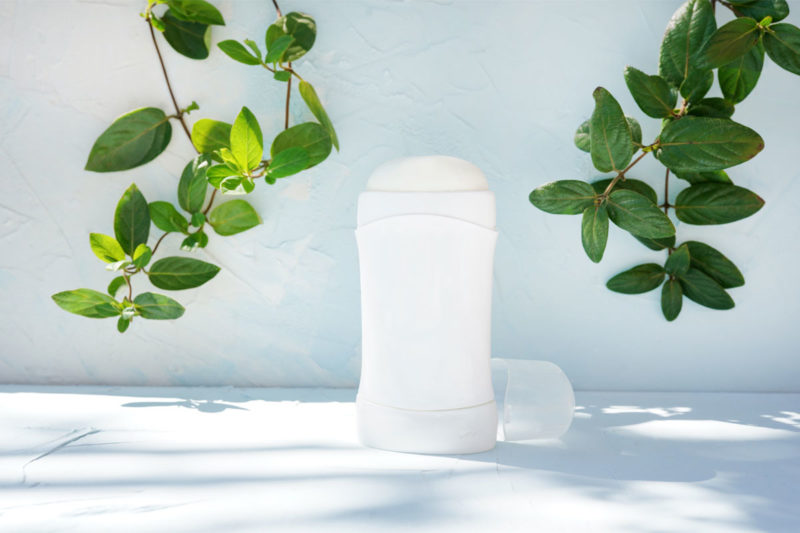It’s hard to go without deodorant. If you’re looking for a formulation that’s safe and effective, let us walk you through the options.
Perspiration plays an essential role, because sweating allows three things to happen:
1 – Control of body temperature at the perfect level of 37° C via thermoregulation. By exiting through the pores of the skin, and not least via the sweat glands, sweat acts as a natural air conditioner. By beading on all or part of the skin, then evaporating, sweat helps to lower the body temperature.
2 – Elimination of toxins, the skin being one of the body’s emunctories (like the liver, intestines, kidneys and lungs) which help this process along. However, these very toxins (made up of bacteria, among other things) generate the odours that we’re trying to mask here.
3 – Moisturisation of the skin, sweat being the body’s primary natural moisturiser. Because it is also part of the hydrolipidic (water + fat) film on the surface of the skin, which protects it and the whole body from dehydration. These two roles may seem contradictory, but they are complementary.
Countering perspiration is not such a good idea… Speaking of which, do you wonder whether deodorant and antiperspirant are the same thing?
Deodorant versus antiperspirant… Which of them does what?
Deodorant, with a cocktail of antibacterial agents and perfumes, aims to mask the foul odours generated by the breakdown of the bacteria in sweat.
Antiperspirant, as its name suggests, seeks to block or at least slow down the flow of perspiration. And therefore, to hinder the natural function of the sweat glands. With agents that form a layer on the surface of armpit skin, it plays a film-forming role by covering these glands. It also acts as an astringent, tightening the pores of the skin and reining in perspiration. If you feel like you sweat excessively, it’s better to embrace a gentler routine. Morning and night, and during the day if necessary, use a flannel or cloth wipe to wash your armpits with soapy water, rinse with lukewarm water and dry thoroughly. This is a simple, effective way to removes bacteria from the surface of the skin naturally. Then top it off with a deodorant (not an antiperspirant) that you feel is clean. And that’s where we can help…
Is there a magic formula?
The demonisation of aluminium salts won’t have escaped you, even though they still feature prominently among the ingredients of a great many so-called “effective” formulations. And for good reason – these aluminium salts that we hear so much about (like the alum stone from which they are derived) tighten the skin’s pores, and very effectively rein in the action of the sweat glands.
“Labs have tried to switch them out in favour of other, safer ingredients,” explains Mahault de Guibert, co-founder of La Rosée. “It’s not about impeding the natural process, just limiting the inconvenience of it. First of all, we absorb excess sweat with “spongelike” active ingredients such as charcoal powder, clay, corn starch, arrowroot powder or diatomaceous earth. Fun fact -arrowroot is extracted from the rhizome of a tropical plant (maranta arundinacea) which is immersed in hot water before being peeled and then ground. The pulp is extracted, dried and then ground into powder. It gets its odd name from the fact that Native American Indians used it to heal arrow wounds. As for diatomaceous earth, it is derived from a siliceous sedimentary rock (diatomite). These ingredients are highly porous and absorb moisture imperceptibly and gently. We then combine these sweat absorbers with safe odour neutralisers such as coconut oil and magnesium.
But what is most interesting is the new strategy that natural cosmetics laboratories have decided to explore: probiotics.
“We know that perspiration raises the pH of the skin and leads to the proliferation of foul-smelling bacteria. So we layer on probiotics, “friendly” bacteria, to take the place of the “hostile” bacteria. Thus the microflora is regulated in a way that is very respectful of the skin”, explains Mahault de Guibert.
Out with…
- Alcohol, ethyl alcohol and ethanol, which are often too much of an irritant.
- Propellant gases (butane, pentane, propane, ethane and isopentane) which are polluting for the environment as much as for the human body.
- Preservatives such as parabens, methylparaben (except sodium benzoate, which is water-based and well tolerated), sodium and natural preservatives. “There are six or seven different parabens that are not all created equal in terms of toxicity, but it is easier to keep them out of formulations. While phenoxyethanol has taken the place of parabens, some laboratories, including ours, prefer to exclude it too”, explains Salomé Aldrieux, Product Manager at Les Petits Prodiges.
- Types of silicone found in roll-on deodorants. Although these substances make for a soft, creamy texture, clean brands don’t are not keen on them. “Silicone is made from silica, yet not natural, and particularly polluting when shed into waste water from the shower”, stresses Salomé Aldrieux.
- NB: Aluminium salts, or aluminium chlorohydrate, which neutralise the sweat glands and were long suspected of playing a role in breast cancer, have now been cleared by the Scientific Committee on Consumer Safety, but only in certain amounts…
In with…
“We advocate green chemistry, which is clean, and chosen by natural brands, so that you don’t end up with mould in deodorant”, says Mahault de Guibert. The preservative cosgard, derived from benzyl alcohol, is one of the few to have secured Ecocert certification. But there are also natural preservatives: lemon and citric acid, vitamin E, propolis extract, rosemary essential oil and grapefruit seed extract.
We of course advocate formulations that shun everything that is “in the sin bin”, and those that rely on probiotics or fruit acids. “The latter modify the pH of the skin and rein in the proliferation of bacteria, without compromising the natural process of perspiration,” explains Salomé Aldrieux.
We advocate brands certified by Ecocert, whose charter is exacting. You are more likely to find the deodorant of your dreams in stick or roll-on format, or spray format without propellants. The “aerosol” format, which is catastrophic for the planet, is finding it increasingly hard to win consumers over…
We also advocate homemade deodorant, if apprehension over dubious ingredients has you making your own. There are a great many recipes out there. But if you use aloe vera gel, baking soda for cosmetic preparations, some essential oils (palmarosa, lavender or rose), organic coconut oil, beeswax, arrowroot powder or diatomaceous earth, you’ll get good results.







